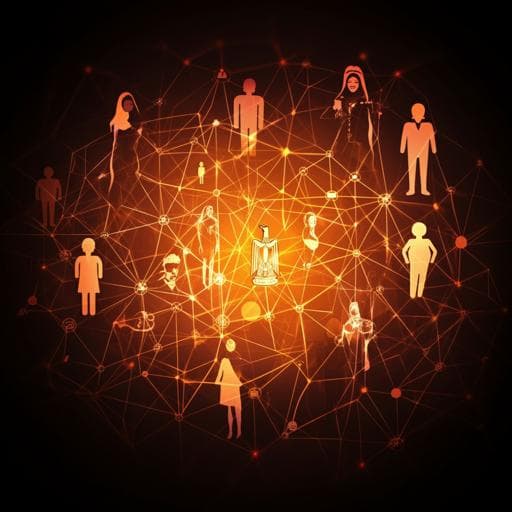
Sociology
Effect of social media usage on the cultural identity of rural people: a case study of Bamha village, Egypt
M. Radwan
This research, conducted by Mostafa Radwan, delves into how social media is reshaping the cultural identity of rural Egyptians in Bamha village. With 40% of respondents reporting significant changes, the study highlights the need for critical thinking and media literacy to harness positive impacts and alleviate negative ones.
~3 min • Beginner • English
Introduction
The study addresses how social media affects the cultural identity of rural people in Egypt. Cultural identity shapes how individuals understand themselves and others and is influenced by socio-cultural elements and media. With the rapid spread of internet and social networking sites in Egypt, concerns have arisen about impacts on values and identity, especially in rural communities governed by traditional norms. The research problem centers on determining the extent to which social media usage changes components of cultural identity and which factors are associated with such change. Guiding questions include: (1) What are respondents’ social, economic, and communication characteristics? (2) Why do respondents use social media? (3) What is social media’s effect on cultural identity components (language/dialogue, community participation, belongingness, time respect, freedom, family cohesion)? (4) What is the relationship between selected socio-economic-communication variables and change in cultural identity? (5) What is the relative contribution of these variables to variance in change? (6) What are perceived positives and drawbacks of social media? The study’s objective is to identify the effect of social media use on cultural identity components among rural users in Bamha village, Egypt, using a 3-point change scale (increased/no change/decreased).
Literature Review
The theoretical framework includes key concepts and prior orientations. Cultural identity encompasses language, values, customs, traditions, and historical struggles to preserve identity (Al-Jabri, 1998; Al-Mahrouqi, 2004; Al-Tuwaijri, 2015; Lesly, 2009). Virtual communities facilitate interaction beyond geographic boundaries, forming personal relationship networks online (Chan et al., 2004; Bodhan, 2009; Jaber, 2003). Social media enables global connection and dialogue, with cultural differences influencing usage patterns (Georgetown University, 2010; Rosen et al., 2010; Hofstede, 2001; Veltri & Elgarah, 2009). The study notes gaps: prior work rarely focused on rural areas, on Egypt/Middle East, or on all components of cultural identity. Theoretical orientations: (1) Symbolic Interactionism—identity is formed/reformed through symbolic interactions in virtual spaces; (2) Giddens’ Structuration—practices on social media reproduce or change cultural practices and identity; (3) Technological Determinism—technology transforms social relations and can both benefit and harm identity; (4) Social Determinism—social relations drive the creation and use of networking technologies. These perspectives underpin interpretation of social media’s effects on identity.
Methodology
Design: Descriptive social survey.
Setting and population: Bamha village, Al-Ayat district, Giza Governorate, Egypt (population 16,128; CAPMAS, 2017). Sampling frame: 5,708 members of the Facebook group “Bamha Village News.”
Sample: n=360 determined via Krejcie & Morgan table; village divided into four sectors, 90 respondents selected per sector using systematic random sampling. Inclusion: social media users (Facebook predominant).
Data collection: December 2021; face-to-face interviews with a structured questionnaire (validated by content experts; Cronbach’s alpha >0.8 for measures). Pretest conducted before fieldwork.
Instrument sections:
- Section 1: Socio-economic characteristics (age, gender, education, marital status, family size, occupation, family monthly income).
- Section 2: Communication characteristics (years of use, daily hours, number of platforms, access means, data validity on profiles, trust in social media content, learning method, favorite site, feelings when away, login name type).
- Section 3: Open question on reasons for social media use.
- Section 4: Effect of social media on six cultural identity components—language/dialogue, community participation, belongingness, time respect, freedom, family cohesion—each with five items rated on a 3-point change scale (increased=3, no change=2, decreased=1 for positive items; reversed for negative items). Total scores computed to express overall change level.
- Section 5: Perceived positives and drawbacks of social media.
Analysis: SPSS v20. Descriptive statistics and weighted averages for reasons/positives/negatives. Pearson correlation for continuous variables and chi-square for nominal variables to assess associations with degree of change in cultural identity. Stepwise multiple regression to estimate relative contributions to variance in cultural identity change.
Key Findings
Sample profile (selected):
- Age: 18–33 (55%), 34–49 (30%), 50–62 (15%). Gender: 85% male. Education: secondary (40%), higher (40%), preparatory (10%), primary (5%), read & write (5%). Marital status: 75% married. Family size: 5–6 members (50%). Occupation: employees (40%), craftsmen (20%), self-employed (15%), students (10%), others (15%). Monthly income: 2000–3000 EGP (55%).
Communication characteristics:
- Years using social media: 1–3 (35%), 4–6 (35%), 7–10 (30%). Daily use: 2–3 h (45%), 4–5 h (35%), 6–8 h (20%). Platforms used: 1–2 (50%), 3–4 (45%). Access means: mobile+computer (60%), mobile only (40%). Profile data validity: some correct (80%); all correct (15%); not correct (5%). Trust in sites: to some extent (80%), fully (15%), not trust (5%). Learned via friends (60%), self (20%), siblings (15%), courses (5%). Preferred site: Facebook (90%). Feelings when away: empty (60%), anxiety (20%), nothing (20%). Login name: real (85%).
Reasons for use (top): communicating with others (88%); finding old/new friends (75%); spending spare time (73.8%); entertainment (72%); political/religious news (70.5%); sports (60%). Lower: job search (42.7%), work requirement (36.1%), buying/selling (22.5%), addiction (16.4%), social appearance (10.3%).
Effects on cultural identity components:
- Language/dialogue: decreased attention to speaking/writing in sound language (60%) and correcting errors (60%); increased use of colloquial (100%), youth slang (95%), and Franco-Arabic (90%).
- Community participation: decreased attending social events (60%) and exchanging visits (60%); increased participation in development initiatives (75%) and in associations/parties (75%); no change in providing social aid (60%).
- Belongingness/affiliation: increased following national team matches (75%); no change for buying Egyptian products (75%), boycotting harmful countries’ products (75%), willingness to sacrifice for homeland (75%), thinking of traveling/emigrating (70% no change).
- Time respect: decreased time management (75%), waking early (75%), using time usefully (70%), keeping appointments (75%); increased postponing tasks (75%).
- Freedom: increased free expression (100%), discussing issues with peers (100%), claiming rights via legitimate means (100%), criticizing development programs/policies (100%); friendship with people of other religions increased for 50% (50% no change).
- Family cohesion: decreased eating with family (70%), allocating time for family discussion (70%), watching matches with family (45% decreased), knowing all family members’ affairs (35% decreased); standing by family in crisis unchanged (100%).
Overall change level: high in 40% of respondents; average 28.1%; low 31.9%.
Associations (Table 10):
- Positive Pearson correlations (p<0.01) with degree of cultural identity change: age (r=0.396), family size (r=0.147), monthly income (r=0.264). Non-significant: years of use (r=0.055), hours of use (r=−0.038), number of sites (r=−0.013).
- Significant chi-square associations (p<0.01): gender (χ2=122.648), education (χ2=656.725), marital status (χ2=620.643748), profession (χ2=314.019), access means (χ2=126.304).
Regression (Stepwise): four variables explained 43.7% of variance in cultural identity change: profession (R2=0.263; F=127.77), age (R2=0.362; F=101.25), gender (R2=0.402; F=79.65), income (R2=0.444; F=70.74); all p<0.01.
Perceived effects of social media:
- Positive (top): facilitating rapprochement/knowing news (89.1%); helping charitable work (86.9%); knowing villagers’ behavior (84.7%); mobilizing public opinion (75.2%); cultural/religious search (73%); job opportunities (69.1%); e-bill payment (65.5%); fun/time (64.2%); developing/displaying talents (56.4%).
- Negative (top): wasting time/poor organization (83.6%); spreading negative values/corruption of morals (74.7%); laziness/lethargy (71.1%); weak direct communication skills (65.3%); falsification of information (63.3%); addiction (58%); neglect in religious rites (55%).
Hypotheses: The null of no relationships was rejected for age, family size, income, gender, education, marital status, profession, and access means; not rejected for years of use, hours of use, and number of sites. The null of no relative contribution was rejected: profession, age, gender, and income jointly explained 43.7% of variance.
Discussion
Findings indicate that social media substantially reshapes multiple components of cultural identity among rural users. Language practices shift toward colloquial/slang and Franco-Arabic; time management and traditional face-to-face social participation decline, whereas civic engagement via associations and public issue discourse increases. Belongingness indicators mostly remain stable. Freedom of expression and policy critique expand markedly. Family cohesion shows mixed effects, with reduced shared routines but stable crisis support.
These outcomes align with symbolic interactionism (identity redefined through online symbolic exchanges), structuration (everyday social media practices reproduce or transform cultural norms), and technological determinism (technology both enabling expression and disrupting traditional routines). Significant associations show that demographic and socio-economic positioning (age, gender, education, marital status, profession, income) and broader access means condition the magnitude of identity change; mere exposure duration or breadth of platforms is less predictive. The model suggests that enhanced connectivity fosters new forms of participation and community while challenging traditional temporal and linguistic norms.
Conclusion
The study contributes evidence from a rural Egyptian context that social media use is associated with notable changes in cultural identity components, particularly language practices, temporal discipline, family routines, and civic expression. It identifies key predictors (profession, age, gender, income) explaining 43.7% of variance in cultural identity change and documents nuanced effects—declines in traditional participation and time respect alongside growth in public discourse and associative involvement. Policy and practice implications include: developing students’ critical thinking and self-learning; promoting pride and use of Standard Arabic (including supportive social media initiatives); encouraging media creators to produce value-preserving content; leveraging social media to channel youth into real-world community service; and fostering coordination among media, schools, religious/civil institutions, and youth centers to maximize benefits and mitigate harms. Future research should broaden samples across regions and demographics, compare rural/urban settings, and track longitudinal changes to better understand causal pathways.
Limitations
The study is limited by: (1) a single-village, rural sample of 360 respondents, which constrains generalizability; (2) cross-sectional design precluding causal inference; (3) limited age-range diversity; and (4) focus on Facebook-dominant users. Future work should include larger, more diverse, multi-community samples (rural and urban), extended age ranges, and longitudinal or mixed-methods designs across different countries to deepen understanding of social media’s impact on cultural identity.
Related Publications
Explore these studies to deepen your understanding of the subject.







